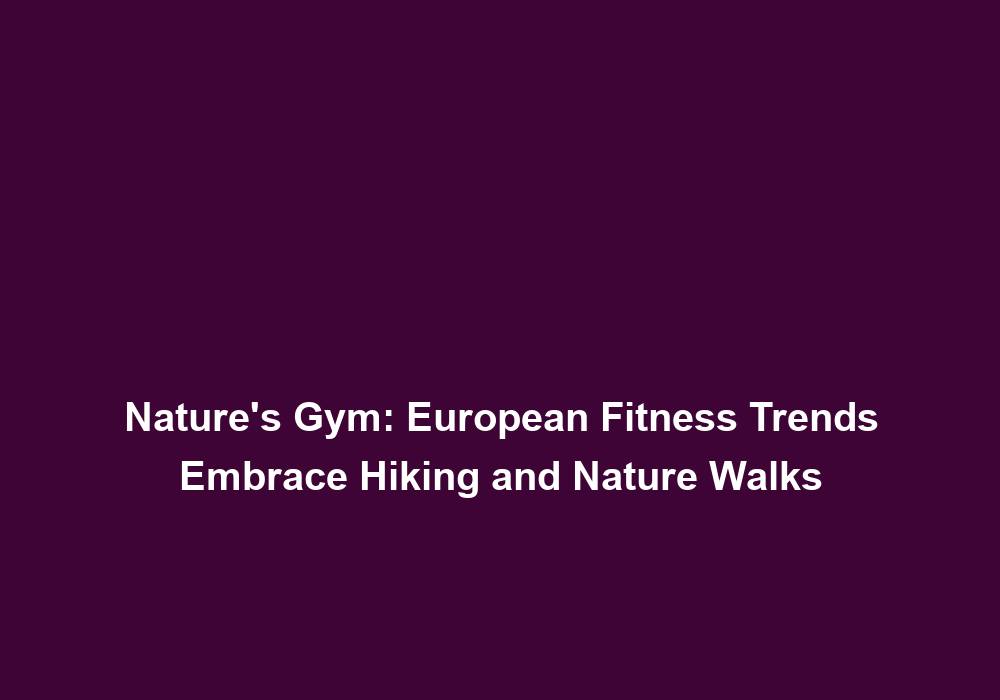Nature’s Gym: European Fitness Trends Embrace Hiking and Nature Walks
In recent years, there has been a significant shift in fitness trends across Europe. More and more people are turning to outdoor activities that allow them to connect with nature while improving their physical well-being. One such trend that has gained immense popularity is hiking and nature walks. These activities not only provide numerous health benefits but also offer a refreshing and rejuvenating break from the daily grind. In this article, we will delve into the reasons behind the growing interest in hiking and nature walks as well as explore the benefits they offer.
The Growing Popularity of Hiking and Nature Walks
Escaping the Monotony of Indoor Gyms
For many fitness enthusiasts, the traditional indoor gym setting can be monotonous and uninspiring. The repetitive routines and confined spaces often become mundane after a while. Hiking and nature walks, on the other hand, offer a chance to break free from the four walls and immerse oneself in the beauty of the great outdoors. The allure of picturesque landscapes, fresh air, and the thrill of exploration make these activities much more appealing than lifting weights indoors.
- Hiking and nature walks provide a sense of adventure and exploration that is lacking in indoor gyms. Exploring new trails and discovering hidden gems in nature can be an exciting and rewarding experience.
- The natural beauty and serenity of outdoor environments can have a calming and rejuvenating effect on the mind. Being surrounded by lush greenery, flowing rivers, and majestic mountains can help reduce stress and improve overall well-being.
- Engaging in outdoor activities like hiking and nature walks allows individuals to escape the distractions of technology and reconnect with the present moment. It provides an opportunity to disconnect from the virtual world and connect with the natural world.
A Holistic Approach to Fitness
Hiking and nature walks provide a holistic approach to fitness by engaging both the body and the mind. Unlike isolated workouts that focus on specific muscle groups, hiking and walking involve the entire body. The uneven terrain and natural obstacles encountered during these activities engage various muscles, resulting in a full-body workout. Additionally, the mental benefits of being surrounded by nature, such as reduced stress levels and improved mood, contribute to an overall sense of well-being.
- Walking on uneven surfaces and navigating through different terrains requires the use of multiple muscle groups, including the legs, core, and upper body. This helps improve strength, endurance, and flexibility.
- The constant adjustments in balance and coordination required during hiking and nature walks enhance proprioception, which is the body’s ability to sense its position and movements. This can improve overall balance and stability, reducing the risk of falls.
- The meditative aspects of walking in nature, such as focusing on the rhythm of your steps and the sounds of the environment, can promote mindfulness and mental clarity. This can be especially beneficial for individuals dealing with stress, anxiety, or depression.
Embracing Sustainable and Eco-Friendly Fitness
With a growing global concern for the environment, many individuals are actively seeking fitness options that align with their eco-friendly values. Hiking and nature walks perfectly fit the bill. These activities have a minimal carbon footprint and do not contribute to environmental degradation. Instead, they promote an appreciation for nature and the need to preserve it for future generations. This sustainable aspect adds an extra layer of appeal for those looking to adopt an environmentally responsible fitness routine.
- Unlike indoor gyms that consume energy and produce waste, hiking and nature walks rely on the natural environment and have a minimal impact on the ecosystem. They allow individuals to enjoy physical activity without harming the planet.
- By engaging in outdoor activities, individuals develop a deeper connection with nature and gain a greater appreciation for its beauty and importance. This can lead to a stronger sense of environmental stewardship and a desire to protect natural spaces.
- Hiking and nature walks often take place in protected areas and national parks, which are dedicated to preserving biodiversity and natural habitats. By participating in these activities, individuals directly support conservation efforts and contribute to the maintenance of these valuable ecosystems.
Connection with Nature and Cultural Heritage
Europe is rich in natural landscapes and cultural heritage. Hiking and nature walks provide an opportunity to explore and connect with both. From the rugged beauty of the Scottish Highlands to the serene landscapes of the Swiss Alps, Europe offers a diverse range of trails and routes for outdoor enthusiasts. Each hike or nature walk provides a chance to witness breathtaking vistas, encounter local wildlife, and discover historical landmarks. This unique blend of nature and culture makes hiking in Europe a truly enriching experience.
- Hiking in Europe allows individuals to immerse themselves in the natural wonders that the continent has to offer. From ancient forests to coastal cliffs, there is a wide variety of landscapes to explore, each with its own unique charm.
- Many hiking trails in Europe pass through culturally significant areas, such as ancient ruins, historic villages, and traditional farmlands. This provides an opportunity to learn about the region’s history, traditions, and local customs.
- Hiking in Europe also offers the chance to interact with local communities and experience their way of life. Whether it’s enjoying traditional cuisine at a mountain hut or participating in local festivals, these encounters add depth and authenticity to the hiking experience.
Health Benefits of Hiking and Nature Walks
Cardiovascular Fitness and Weight Management
Hiking and nature walks are excellent forms of cardiovascular exercise. The varying terrains and inclines encountered during these activities challenge the heart and lungs, improving their efficiency over time. Regular hiking or walking can help lower blood pressure, reduce the risk of heart disease, and contribute to weight management. The combination of aerobic exercise, muscle engagement, and calorie burn makes hiking an effective way to improve overall fitness levels.
- The uphill climbs and uneven terrain encountered during hiking and nature walks require the heart to work harder, increasing cardiovascular endurance. This can lead to a lower resting heart rate, improved circulation, and a reduced risk of cardiovascular diseases.
- The repetitive nature of walking or hiking at a moderate intensity can help burn calories and contribute to weight loss or weight management. By incorporating elevation changes and varying speeds, individuals can further increase the calorie burn during these activities.
- Regular cardiovascular exercise, such as hiking and walking, can help improve cholesterol levels by increasing the levels of “good” cholesterol (HDL) and decreasing the levels of “bad” cholesterol (LDL). This can have a positive impact on heart health and reduce the risk of atherosclerosis.
Joint Health and Bone Strength
Unlike high-impact activities like running or jumping, hiking and nature walks are low-impact exercises that are gentle on the joints. The natural cushioning provided by uneven terrain reduces the risk of joint injuries and helps improve joint flexibility and mobility. Furthermore, walking on trails with different inclines and surfaces stimulates the body’s natural bone-building process, leading to stronger bones and reduced risk of osteoporosis.
- The shock-absorbing properties of natural surfaces, such as dirt paths or forest floors, help minimize the impact on joints, making hiking and nature walks ideal for individuals with joint conditions or those looking for a low-impact exercise option.
- Walking on uneven terrain requires the engagement of stabilizing muscles around the joints, which can help improve joint stability and reduce the risk of injuries, such as sprains or strains.
- Weight-bearing exercises, such as hiking and walking, stimulate bone growth and help maintain bone density. This is particularly important for individuals at risk of osteoporosis, a condition characterized by weak and brittle bones.
Mental Well-being and Stress Reduction
Spending time in nature has been proven to have a positive impact on mental health. Hiking and nature walks offer a respite from the hustle and bustle of everyday life, allowing individuals to unwind and relax. The calming effect of natural surroundings, coupled with the physical activity involved, releases endorphins – the feel-good hormones that boost mood and reduce stress levels. Additionally, the meditative aspects of walking in nature provide an opportunity for introspection and self-reflection, promoting mental clarity and a sense of inner peace.
- Nature has a soothing effect on the mind, reducing stress, anxiety, and symptoms of depression. The combination of fresh air, natural sounds, and green landscapes creates a peaceful environment that helps individuals relax and recharge.
- The physical activity involved in hiking and nature walks releases endorphins, which are neurotransmitters that promote feelings of happiness and well-being. These natural mood boosters can help alleviate symptoms of mild to moderate depression and improve overall mental health.
- Walking in nature provides a break from technology and the constant stimulation of screens, allowing individuals to disconnect from the digital world and reconnect with themselves. This can lead to increased mindfulness, improved focus, and enhanced mental clarity.
Improved Balance, Coordination, and Agility
Walking on uneven terrain requires constant adjustments in balance and coordination, thereby improving these skills over time. Stepping over rocks, navigating tree roots, and crossing streams all contribute to enhancing agility and proprioception. These improvements in balance and coordination have a significant impact on everyday activities and reduce the risk of falls, particularly among older adults.
- The diverse terrain encountered during hiking and nature walks challenges the body to maintain stability and balance. This can help improve proprioception, which is the body’s awareness of its position in space. Enhanced proprioception can reduce the risk of falls and improve overall mobility.
- The need to navigate obstacles, such as tree branches or slippery rocks, requires precise coordination and quick reflexes. Over time, this can lead to improved agility and coordination, making everyday tasks easier and reducing the risk of accidents.
- The constant adjustments in balance and foot placement during hiking and nature walks engage the muscles responsible for stabilizing the body, such as the core and leg muscles. This can lead to improved muscle strength and stability, further enhancing balance and reducing the risk of falls.
Tips for Safe and Enjoyable Hiking and Nature Walks
To ensure a safe and enjoyable hiking or nature walking experience, it is essential to follow a few guidelines:
- Choose appropriate footwear: Invest in a sturdy pair of hiking boots or walking shoes that provide good ankle support and traction.
- Dress in layers: The weather in Europe can be unpredictable, so dressing in layers allows for easy adjustments to changing temperatures.
- Carry essential supplies: Pack a backpack with essentials such as water, snacks, a map or compass, a first aid kit, and sunscreen.
- Know your limits: Start with shorter, less challenging trails if you are a beginner. Gradually increase the difficulty level as your fitness improves.
- Respect nature and local regulations: Stay on designated trails, leave no trace, and follow any rules or regulations set by local authorities to preserve the environment.
- Consider hiking with a group: Hiking with others not only enhances the experience but also ensures safety in case of unforeseen circumstances.
Conclusion
Hiking and nature walks have become a popular fitness trend across Europe due to their ability to combine physical exercise with a deep connection to nature. The numerous health benefits, both physical and mental, make these activities an ideal choice for individuals seeking a holistic approach to fitness. The sustainable and eco-friendly nature of hiking and nature walks further adds to their appeal. So, lace up your hiking boots, grab a backpack, and embark on a journey to explore the beautiful landscapes that Europe has to offer. Happy hiking!







